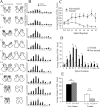Step training reinforces specific spinal locomotor circuitry in adult spinal rats
- PMID: 18632941
- PMCID: PMC6670403
- DOI: 10.1523/JNEUROSCI.1881-08.2008
Step training reinforces specific spinal locomotor circuitry in adult spinal rats
Abstract
Locomotor training improves function after a spinal cord injury both in experimental and clinical settings. The activity-dependent mechanisms underlying such improvement, however, are sparsely understood. Adult rats received a complete spinal cord transection (T9), and epidural stimulation (ES) electrodes were secured to the dura matter at L2. EMG electrodes were implanted bilaterally in selected muscles. Using a servo-controlled body weight support system for bipedal stepping, five rats were trained 7 d/week for 6 weeks (30 min/d) under quipazine (0.3 mg/kg) and ES (L2; 40 Hz). Nontrained rats were handled as trained rats but did not receive quipazine or ES. At the end of the experiment, a subset of rats was used for c-fos immunohistochemistry. Three trained and three nontrained rats stepped for 1 h (ES; no quipazine) and were returned to their cages for 1 h before intracardiac perfusion. All rats could step with ES and quipazine administration. The trained rats had higher and longer steps, narrower base of support at stance, and lower variability in EMG parameters than nontrained rats, and these properties approached that of noninjured controls. After 1 h of stepping, the number of FOS+ neurons was significantly lower in trained than nontrained rats throughout the extent of the lumbosacral segments. These results suggest that training reinforces the efficacy of specific sensorimotor pathways, resulting in a more selective and stable network of neurons that controls locomotion.
Figures



References
-
- Bareyre FM, Kerschensteiner M, Raineteau O, Mettenleiter TC, Weinmann O, Schwab ME. The injured spinal cord spontaneously forms a new intraspinal circuit in adult rats. Nat Neurosci. 2004;7:269–277. - PubMed
-
- Bonnot A, Morin D. Hemisegmental localisation of rhythmic networks in the lumbosacral spinal cord of neonate mouse. Brain Res. 1998;793:136–148. - PubMed
-
- Carr PA, Huang A, Noga BR, Jordan LM. Cytochemical characteristics of cat spinal neurons activated during fictive locomotion. Brain Res Bull. 1995;37:213–218. - PubMed
Publication types
MeSH terms
Grants and funding
LinkOut - more resources
Full Text Sources
Other Literature Sources
Medical
